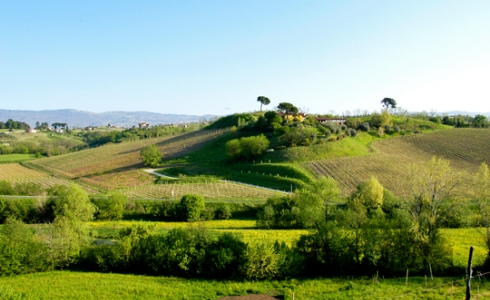

 Wine for Salad?
Wine for Salad?
We've found 46 wine(s) in our Italian Wine Guide which are good for Salad.
Read more

With its location in northern Italy, Veneto borders Lombardia to the west, Trentino-Alto Adige to the north-west, Austria to the north, Friuli Venezia-Guilia and the Adriatic Sea to the east and Emilia Romagna to the south. Protection from the Alps, Lake Garda’s warmth and mildness, the plain’s continental climate and other meterological conditions create very favorable conditions for wine production in Veneto.
It’s thought that Veneto is named after an Illyrian tribe, the Venetians, who lived in the area in ancient times, and the area has been known for wine production since the Etruscans. Archeological discoveries date back to around 1000 B.C.
Roman literature relates the excitement surrounding the wine, Retico, a concentrated and elegant Passito (dessert or meditation wine), and there is compelling evidence that the wine was actually a predecessor to the dessert wine and aperitif Recioto della Valpolicella and Recioto di Soave. As was the case at that time, the grapes are still grown on a pergola, and their still dried on stands or straw mats in ventilated lofts, exactly as has been done for centuries.
Veneto’s wine menu includes 25 DOC and 2 DOCG types, and it has the highest production compared to the other regions’ DOC. That is partly due to the mass production of the 1960s and 70s, when Valpolicella, Bardolino and Soave were produced and marketed effectively. Soave was the most sold wine in the US and Valpolicella was tremendously successful in Europe, but the consequence was poor quality at low prices.
Fortunately during the 1980s and 90s the situation changed, partly because the yield per hectare was reduced. Veneto still has mass production, but they manage to maintain a high level of quality at the same time. The small producers are doing better and better, especially the ones who make single-vineyard wines.
In Soave, an association of wineries have set new standards with fantastic white wines, and in Valpolicella they’re working hard to make the voluminous and powerful Amarone more accessible. At the same time, efforts are being made to give the light Valpolicella more weight, volume and balance. The Ripasso type is an example of one that’s also been a good seller, and other types have also performed well.
In the central ridges surrounding Vicenza and Padova, a wide variety of both local and ”foreign” grapes are cultivated. The ridges Colli Euganei, west of Venezia, have some exciting wines to offer, and in the hills between Conegliano and Valdobbiadene we find Prosecco, a worthy competitor to the sparkling wines from Asti in Piemonte, and to champagne for that matter. Lovely, fresh and sweet Spumante or Frizzante types.
In the Venezia province, that stretches northeast along the coast of the Adriatic Sea past the Piave and Lison-Pramaggiore DOC zones, there is a veritable treasure chest of Merlot and Cabernet types. Finally, there’s the eastern part of Veneto, where the Pinot, Chardonnay, Sauvignon, Verduzzo, Tocai and the red Raboso grapes dominate.
There are also tons of opportunities for the wine tourist. Every year in April, one of Italy’s most important wine fairs takes place in Verona, Vinitaly, and if you don’t get enough there, there are countless wine routes in the region, along with some completely wonderful ’enotece’, wine stores, with a selection for every taste.
Read more about the wines from Veneto by clicking i the top menu in the right side.
That Italy in 2011 was the worlds largest wine producer?